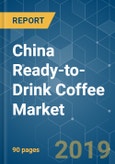Market Overview
China Ready-to-Drink (RTD) Coffee Market is witnessing a CAGR of 3.5% during the forecast period (2019-2024).
Scope of the Report
The scope of China Ready-to-Drink (RTD) Coffee Market is segmented by distribution channels (Supermarkets/Hypermarket, Convenience stores, Foodservice channels, Online retail, and Other Distribution Channels).
Key Market Trends
Increase in number of Specialty stores
Coffee consumption is increasing in China and is going to increase during the forecast period. There is a trend towards coffee culture which has been developed over the last decade largely due to the influence of Cosmopolitan Beijing and Shanghai. The Younger generation think Coffee as a way of life and Coffee shop trend is all about the environment, the comfort, and fashion. Further health awareness among educated consumers with comparatively strong consumption are interested in purchasing coffee in Speciality stores. Coffee Chains like Starbucks have been pushing coffee culture onto young people, who now enjoy hanging out drinking out with friends in coffee shops. With this growing coffee shop trend, there is a rise in the number of Speciality stores in China and is going to propel the RTD coffee market during the forecast period.
Growing Preference for Coffee over Tea
Consumers in China are preferring coffee over tea as it appeals to adventurous young, rich, and urban consumers. This is because originally coffee is considered as a Western concept by most Chinese consumers. Manufacturers have targeted Westernized young professionals as the main target market for RTD coffee. Another large consumer group that influences RTD coffee consumption is returnees. Many of these returnees have lived in Western countries for a decade and have become accustomed to the RTD coffee culture. Upon their return to China, they continue living in the manner they have become accustomed to. Foreign expatriates making them as a large proportion of coffee consumers in China. China doubled its coffee imports from 2012-2017. This is a mostly urban phenomenon, with most rural areas largely untapped. This untapped potential is going to propel the demand for RTD coffees during the forecast period.
Competitive Landscape
Mar 2015 - Starbucks and Chinese food and beverage producer Tingyi Holding Corp. has entered into an agreement to manufacture and expand the distribution of Starbucks ready-to-drink (RTD) products throughout mainland China.
China Ready-to-Drink (RTD) Coffee Market includes the company profiles of Nestle S.A, Barista, Starbucks Corporation, Suntory Holdings Ltd., Uni-President Enterprises Corp., The Coca-Cola Company, Tsing Hsin International Group, and Pepsico Inc.
This product will be delivered within 2 business days.
China Ready-to-Drink (RTD) Coffee Market is witnessing a CAGR of 3.5% during the forecast period (2019-2024).
- Coffee consumption in China is highly concentrated in large cities such as Beijing, Shanghai, and Guangzhou. Recently, coffee appeals to adventurous young, rich, and urban consumers. This is because originally coffee is considered as a Western concept by most Chinese consumers. Manufacturers have targeted Westernized young professionals as the main target market for RTD coffee.
- Another large consumer group that influences RTD coffee consumption is returnees. China doubled its on-trade coffee consumption between 1998 and 2003. This is a mostly urban phenomenon, with most rural areas largely untapped. The demand for RTD market is going to propel further during the forecast period.
Scope of the Report
The scope of China Ready-to-Drink (RTD) Coffee Market is segmented by distribution channels (Supermarkets/Hypermarket, Convenience stores, Foodservice channels, Online retail, and Other Distribution Channels).
Key Market Trends
Increase in number of Specialty stores
Coffee consumption is increasing in China and is going to increase during the forecast period. There is a trend towards coffee culture which has been developed over the last decade largely due to the influence of Cosmopolitan Beijing and Shanghai. The Younger generation think Coffee as a way of life and Coffee shop trend is all about the environment, the comfort, and fashion. Further health awareness among educated consumers with comparatively strong consumption are interested in purchasing coffee in Speciality stores. Coffee Chains like Starbucks have been pushing coffee culture onto young people, who now enjoy hanging out drinking out with friends in coffee shops. With this growing coffee shop trend, there is a rise in the number of Speciality stores in China and is going to propel the RTD coffee market during the forecast period.
Growing Preference for Coffee over Tea
Consumers in China are preferring coffee over tea as it appeals to adventurous young, rich, and urban consumers. This is because originally coffee is considered as a Western concept by most Chinese consumers. Manufacturers have targeted Westernized young professionals as the main target market for RTD coffee. Another large consumer group that influences RTD coffee consumption is returnees. Many of these returnees have lived in Western countries for a decade and have become accustomed to the RTD coffee culture. Upon their return to China, they continue living in the manner they have become accustomed to. Foreign expatriates making them as a large proportion of coffee consumers in China. China doubled its coffee imports from 2012-2017. This is a mostly urban phenomenon, with most rural areas largely untapped. This untapped potential is going to propel the demand for RTD coffees during the forecast period.
Competitive Landscape
Mar 2015 - Starbucks and Chinese food and beverage producer Tingyi Holding Corp. has entered into an agreement to manufacture and expand the distribution of Starbucks ready-to-drink (RTD) products throughout mainland China.
China Ready-to-Drink (RTD) Coffee Market includes the company profiles of Nestle S.A, Barista, Starbucks Corporation, Suntory Holdings Ltd., Uni-President Enterprises Corp., The Coca-Cola Company, Tsing Hsin International Group, and Pepsico Inc.
This product will be delivered within 2 business days.
Table of Contents
1 INTRODUCTION
3 EXECUTIVE SUMMARY
4 MARKET DYNAMICS
5 MARKET SEGMENTATION
6 COMPETITIVE LANDSCAPE
Companies Mentioned (Partial List)
A selection of companies mentioned in this report includes, but is not limited to:
- Nestle S.A
- Starbucks Corporation
- Suntory Holdings Ltd
- Uni-President Enterprises Corp.
- The Coca-Cola Company
- Tsing Hsin International Group
- Pepsico Inc.
- Barista
Methodology

LOADING...








